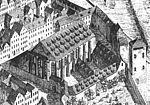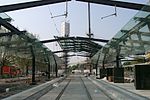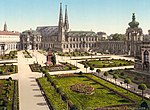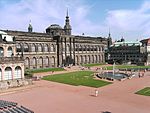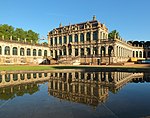Trams in Dresden
600 V DC railway electrificationTown tramway systems by cityTram transport in GermanyTransport in Dresden

The Dresden tramway network (German: Straßenbahnnetz Dresden) is a network of tramways forming the backbone of the public transport system in Dresden, a city in the federal state of Saxony, Germany. Opened in 1872, it has been operated since 1993 by Dresdner Verkehrsbetriebe (DVB), and is integrated in the Verkehrsverbund Oberelbe (VVO). As of 2008, the network comprised 12 tram lines, with a total line length of approximately 210 kilometres (130 mi) and a total route length of 132.7 kilometres (82.5 mi). There was 291.6 kilometres (181.2 mi) of track, which translated into 132.7 kilometres (82.5 mi) of actual tram line, serving 154 tram stops.
Excerpt from the Wikipedia article Trams in Dresden (License: CC BY-SA 3.0, Authors, Images).Trams in Dresden
Postplatz, Dresden Innere Altstadt (Altstadt)
Geographical coordinates (GPS) Address Nearby Places Show on map
Geographical coordinates (GPS)
| Latitude | Longitude |
|---|---|
| N 51.050833333333 ° | E 13.733333333333 ° |
Address
Postplatz
Postplatz
01067 Dresden, Innere Altstadt (Altstadt)
Saxony, Germany
Open on Google Maps


